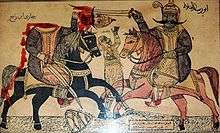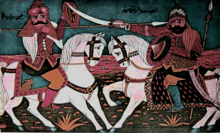Taghribat Bani Hilal

Al-Sirah al-Hilaliyyah, also known as the Sirat Bani Hilal and the al-Hilali epic, is an Arabic epic oral poem that recounts the tale of the journey of the Bedouin tribe of the Banu Hilal from Najd in Arabia to Tunisia and Algeria via Egypt. It is built around historical events that took place in the 11th century. The Banu Hilal were dominant in central North Africa for over a century before their annihilation by rivals from Morocco. The epic is folkloric and oral, not having been committed to writing until relatively recent times, and doesn't have a well-defined date of creation. Of the dozen odd major oral epic poems that developed within the Arab folk tradition between the Middle Ages and the 19th century, Sirat Bani Hilal is today the only one that is still performed in its integral musical form. The epic, once widespread throughout the Middle East, is today performed only in Egypt. In 2008 it was inscribed on UNESCO's Representative List of the Intangible Cultural Heritage of Humanity.[1]
Historical background
The event of Taghribat Bani Hilal has a basis in history, when Zirid Tunisia broke away from the Fatimid empire in the 11th century.
Early sources describe how the Fatimid Caliph sent the Banu Hilal to the Maghreb lands to punish the Zirids for rebelling.
The epic has come to represent a foundational myth for Arab identity in North Africa and the spread of Islam across the Sahara effecting the cultural heritage of countries as far south as Sahel states such as Mali and Niger.
The epic, performed since the 14th century, has been sung in verses by master poets who provide their own musical accompaniment on a percussion instrument. It is a unique literary and musical form that reflects in it Arab folk history, customs, beliefs, symbolism and traditions. Proverbs and puzzles derived from the epic are often a part of everyday conversation in many areas of the Middle East.[2] Some of the prominent characters of the epic include Abu zed al-Hilaliy, El Zenaty Kalepha and Zayab Ibn Ganem and there are several places in the Middle East that have been named for heroes mentioned in the epic. The Al-Sirah Al Hilaliyyah exalts courage and heroism and has in it themes of honour and revenge and of war and romance. It places events from a recalled and orally transferred history in their social and historical contexts and is a record of customs and practices and the food, clothing and lifestyles of these communities across time.[3][4]
This crude political act had two major effects, one cultural, and the other literary.As a result of Arabic-speaking tribes settling Tunisia, this region became mainly Arabic speaking, and not Berber.
Epic

The epic was inspired by these historic events. In it the Hilali leader Abu Zayd al-Hilali's rival is Khalifa al-Zanati, the hero of the tribe of Zenata. The war between the Arab Banu Hilal and the Berber Zenata is the main theme of the Sira named after Abu Zeid. Another character featured in the epic is Shehta (شحتة).
The Sira was initially carried orally and handed down from generation to generation often in poem form via bards and then recorded later in many variants.
The Egyptian poet and writer Abdel Rahman el-Abnudi has made an exhaustive collection of the Sira, travelling from Egypt to Libya to Tunisia to document the variants of the epic.
The epic was narrated by storytellers in cafés well into the 20th century, much like the Baibars biography.
The Hilali performance
The Hilali performers come from specific families for whom these performances were once used to be their sole source of income. The performers often begin their apprenticeships at the age of five and their training goes on for at least ten years. During the course of this demanding apprenticeship the poets perfect their memory, singing and instrument playing skills and learn the art of extemporaneous commentary to render traditional plots relevant to their contemporary audiences. Traditionally, the Al-Sirah Al-Hilaliyyah has been performed at social and private events such as weddings, circumcision ceremonies and private gatherings and the performances often last between 50 to 100 hours.[4]
The Hilali performances have musical accompaniments mostly of wooden instruments. These include string instruments such as the rababa (the Arabic fiddle) and smsmiyya (tampura), wind instruments such as the salamiyyah, zummarah, mizmar, arghul and nay (an open ended flute) and percussion instruments such as the tabla and the tambourine.[5]
Cultural relevance in Egypt
Al-Sirah Al-Hilaliya is a living tradition that symbolises the oral traditions of communities of Upper and Lower Egypt and it blends ancient and modern music with songs and dances of the present tribes of Egypt. The Hilali thus has a considerable influence in shaping these communities’ vision, their acceptance or rejection of ideas and innovations and it helps integrate changes associated with development, modernisation in these societies.[4]
Threats to survival
Today there are very few folk poets who know Al-Sirah Al-Hilaliya in its entirety and given the socio economic changes in Egypt and the onslaught of globalisation, the Hilali epic is faced with the prospect of extinction. Documentation, classification and archiving of the epic and its artistic nuances are underway and its listing on the List of the Intangible Cultural Heritage of Humanity is expected to brighten its prospects of survival.[1] The Al-Sirah Al-Hilaliyyah bears resemblance to the T'heydinn of Mauritania, another oral epic on the Intangible Cultural Heritage List, both as an oral history and in the source material of the exploits of the Beni Hilal tribe that both these epics derive from.
See also
References
- 1 2 "Al-Sirah Al-Hilaliyyah epic". UNESCO.
- ↑ "Al-Sirah Al-Hilaliyyah Epic". Archived from the original on 28 April 2012. Retrieved 25 July 2012.
- ↑ "Traditional Egyptian storytellers' heritage - Call for partnership".
- 1 2 3 Kamil, Jill (9–15 September 2004). "The tale of a tale". Al Ahram Weekly. Issue No. 707. Archived from the original on 5 May 2014.
- ↑ "Traditional Egyptian storytellers heritage and its instruments and tools".
Further reading
- Galley, Micheline. "‘À propos d’un manuscrit de la geste hilalienne conservé à la Bibliothèque Vaticane’." 'Studies on Arabic epic’ (ed. Giovanni Canova), xxii (L XXX III), Oriente Moderno (special number), n.s. 2 2003, pp. 307–33.
